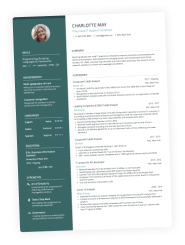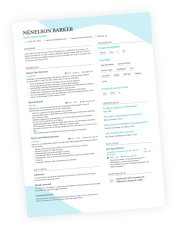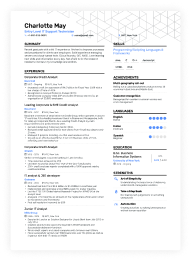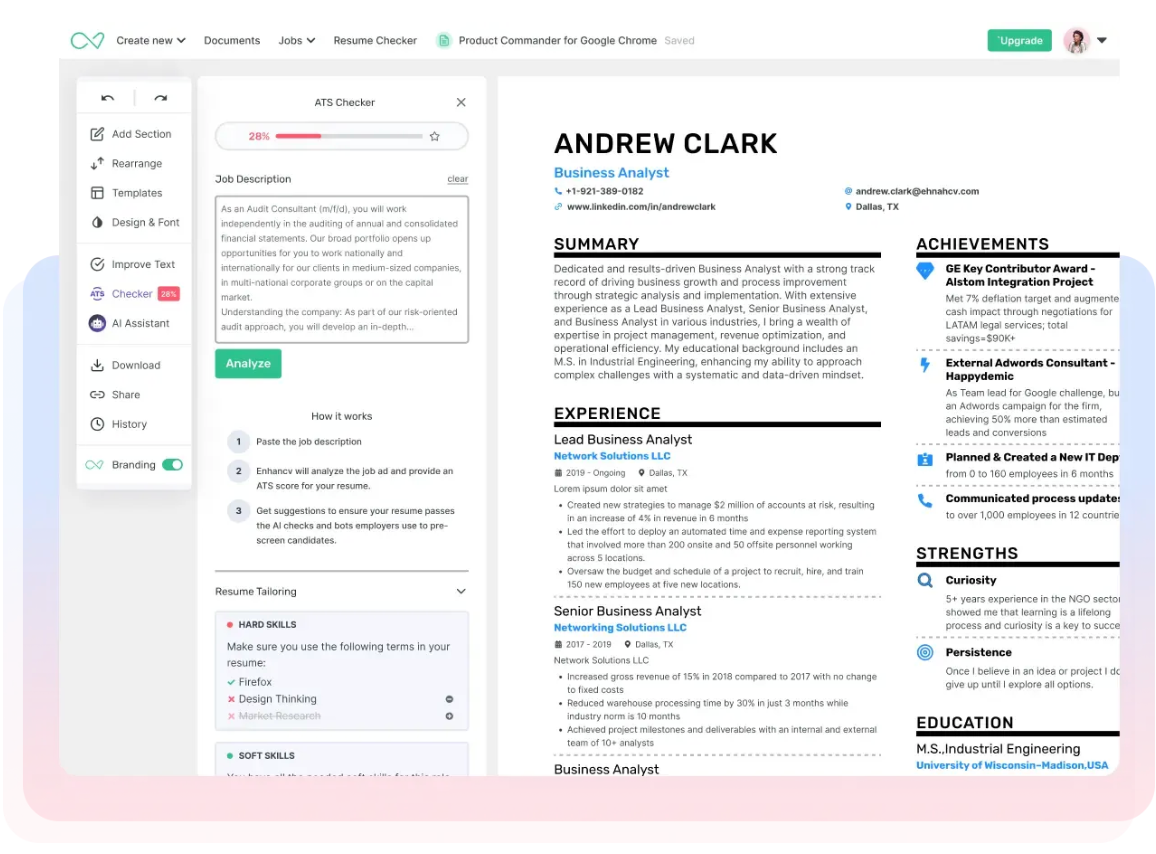Your CV isn’t the place to be modest about your achievements. If you’ve excelled in a role, now’s the time to say so. The goal here is to show the hiring manager you can make a real difference. Because, if you’ve done something exceptional before, there’s every reason to believe you can do it again.
But here’s the awkward truth: We Brits are not used to self-promotion or tooting our own horn. We simply weren’t brought up that way. So, if the idea of bragging about your big “wins” makes you cringe, you’re not alone. Still, pushing past that discomfort comes with real advantages. Your achievements matter to employers—they may be the difference between landing an interview and getting rejected.
In the following guide, we’ll be covering what counts as achievements on your CV, where you can share them, and how to position them to give you the best chance of success.

Key takeaways
- Be clear and specific about your achievements, and avoid vague statements or simply listing responsibilities.
- Focus on results and include measurable impact wherever possible.
- Choose only the most relevant and impressive achievements for each application.
- Place achievements in your work experience section, or consider adding them to a dedicated section or your summary.
- Tailor your achievements to match the job description and use keywords to get past ATS systems.
- Keep your CV concise by limiting each role to three to five strong achievement bullets.
Is your CV shining a light on your top successes? Check that it’s doing its job now. Use our free CV Checker and get the answers you need.
Is your CV good enough?
Drop your CV here or choose a file. PDF & DOCX only. Max 2MB file size.
First up, we’ll be looking at what actually counts as a CV achievement.
What counts as achievements for a CV?
Before we get to which achievements to put on your CV, let’s talk about what they are.
CV achievements are solid examples of how you’ve made a difference in a role. These highlights show the hiring manager that you can get things done—and they’re often accompanied by metrics to prove it.
Achievements vs. responsibilities: What’s the difference?
Many job-seekers mix up CV achievements and responsibilities, but these are not the same thing. Knowing the difference is essential when you’re writing applications.
An achievement is meeting or exceeding a goal that was given, or a personal goal that was set that has measurable results that positively impacted the organisation
A responsibility is a duty or aspect of the job that was identified before assuming the role, or one that is outlined in the requirements of the position as the role evolved.
Need to figure out which you’re dealing with? Take a look at our table below:
Difference between responsibilities and achievements
| Achievements | Responsibilities |
|---|---|
|
|
Here’s an example of how a CV achievement may look:
CV achievement example
“Increased sales by 20% in first quarter by implementing a new pipeline.”
On the other hand, this is how a responsibility looks:
Responsibility example
“Monitored the sales pipeline and reported back to management team.”
Including plenty of top-notch achievements on your CV is a quick way to turn the hiring manager’s head. But what are the different types you can use?
Types of achievements for your CV
If you’re struggling to pin down what counts as an achievement, it may help to break them into clear categories. Think about the moments you’ve delivered real value, solved problems, or made things better.
Let's take a look at four of the main types below:
1. Quantifiable results
Let’s say you’ve increased revenue, saved the business time, or improved your department’s processes. Congrats… those are all major wins. Plus, if you can quantify them on your CV, that’s a speedy way to show the hiring manager your value.
Hiring managers are looking for results. They want to know, concretely, what they can expect from you if they hire you. Oftentimes they will skim past anything that isn't quantifiable.
This category is about anything you can put a number on. So, if you can attach a percentage, figure, or time frame to it, it’s quantifiable. Numbers make your impact concrete, and are likely to catch the reader's attention. Don’t shy away from them.
2. Awards or recognitions
Whether you’ve been “Employee of the Month” or won the “Best Salesperson” award, these acclaims are worth talking about. Recognitions like these make the hiring manager stop and think “Hmm… this professional has real value,” since you’ve already achieved something notable.

PRO TIP
“Award-winning” is not a figurative term.
If you’ve yet to win any awards (yet!), don’t use this phrase on your CV. Saying you’re an “award-winning writer” when you have no awards to speak of isn’t an exaggeration. It’s a lie.
Not convinced? Read our guide about why lying on your CV is a big risk.
If you’re looking to stop the show, add your awards and recognitions to your CV. Just make sure they’re relevant to the role. For example, your “Top Figure Skater” award is unlikely to impress when you’re applying to work as a dental nurse.
3. Promotions or leadership roles
Climbing the corporate ladder is nothing short of impressive. Promotions, raises, and taking on more responsibilities are all signs you’re on the right track. Be sure to highlight these on your CV, and make it clear when you took a giant step up. Hiring managers are always on the hunt for sheer ambition.
4. Positive changes you’ve made
Lastly, don’t forget your more holistic achievements—i.e. the changes you’ve made to the business. How have you positively impacted the company since you joined? Examples may include developing a new system that sped things up, rethinking a process, or coming up with creative ideas that wowed the team.
Chances are, a handful of your top achievements have sprung to mind. But which should you choose?
How to decide what achievements to put on a CV
You can’t afford to waste space on your CV. Once you have a list of accomplishments ready, it’s time to be brutal and edit it down. Only the very best deserve a spot on your next application.
Deciding what to include doesn’t need to be complicated. But if you’re not sure where to start, we have a simple way to figure it out below.

Reasons to include an achievement
If an achievement ticks one of these boxes, it’s likely worth adding:
- Eye-catching: It stands out as impressive and will grab the hiring manager’s attention.
- Role-specific: It closely matches a key responsibility in the job you’re applying for.
- Company-specific: It reflects the organisation’s vision or goals.
Once you’ve made a shortlist, you need to know where to put your achievements on your CV.
Where should you include achievements on a CV?
You want your accomplishments to be the star of the show, and so choosing the right place to put them is a must. The best option is usually your work experience section. However, there are times when you may want to use the other sections, too.
Work experience section
If your work experience section is just a list of your duties and tasks, you’re missing a trick. There’s space to include impressive achievements here. Place them below the corresponding role.
Work experience with achievements example
Customer Success Manager
Dot-to-Dot Agency – London, UK | Apr 2019 – Jul 2024
- Supported 50+ clients, leading to a 20% increase in renewals.
- Introduced a faster onboarding process, cutting setup time by 30%.
- Created simple user guides, reducing support requests by 15%.
- Worked with sales to find upsell opportunities worth an extra £120K a year.
- Led quarterly feedback sessions that improved satisfaction scores from 82% to 91%.
You can talk about multiple achievements in this section, each adding more value to your application. But keep them short and sweet.
While you should always include accomplishments in your work experience section, there are two other areas you might not have considered.
Dedicated section
Let’s say your career has been a long history of accomplishment after accomplishment. If that’s the case, you may want to draw extra attention to these feats. You can do that in a dedicated section. Call it something simple like “Key Achievements” or “Career Highlights,” and add some bullet points.
Key achievements section example
Key Achievements
- Sales boost
Increased online sales by 35% in 12 months by introducing targeted email campaigns. - Launched new system
Launched a new inventory tracking system that reduced stock errors by 40%. - Led the team
Led a cross-department project to improve customer service, raising satisfaction scores from 78% to 90%. - Won new business
Secured £250K through networking and tailored proposals.
This section should sit near the top of your CV so it stands out to readers. Keep in mind that this should only include stand-out accomplishments—especially those that align with the vacancy at hand.
Summary section
Hiring managers pay close attention to CV summaries. This is a snapshot of your career highlights to date. So, if you have some remarkable achievements you want to share, include them here.
Summary with achievements example
Summary
Marketing professional with 8 years’ experience helping brands grow their online presence and revenue. Increased annual sales by 28% through targeted campaigns, introduced a CRM system that boosted lead conversion by 35%, and launched a content strategy that doubled website traffic in 18 months.
Every word in your summary section needs to showcase your value. Don’t waste space by shoehorning in “accomplishments” that aren’t impressive. Save this area for the crème de la crème.
Now, let’s look at the type of achievements you might share.
How to write your accomplishments on a CV
Ready to share some prime achievements on your CV? There’s a knack to getting it right. Luckily, we have a formula that will help you navigate this part of the process.
When listing your achievements, use the STAR method, as follows:
- Situation: Include the situation that you were in, i.e. the problem or challenge.
- Task: Add the task you had to complete, starting with an action verb.
- Action: Describe what action you took to reach your goal and complete the task.
- Results: Outline the results of this action, including all-important metrics.
Don’t skip how your achievement helped the business as a whole. Hiring managers want to see that your efforts have a real impact that—they hope—is repeatable in the next role.
Here’s a simple structure to help you frame it:

Describing CV achievements using the STAR method
[Action verb] + [what you did] + [why you did it / challenge you addressed] + [result / outcome with numbers]
Example:
“Reduced customer complaint response time by 40% by creating a new triage system in Zendesk, improving client satisfaction scores and easing team workload.”
Let’s put that advice into practice, shall we?
Career highlights and achievements examples
Here are some examples for different career levels:
Entry-level role examples
If you’re new to the working world, you might think you don’t have a wealth of CV achievements. But even smaller impacts can make a big difference to your application. Whether you’ve worked part-time jobs, smaller gigs, or volunteered, consider how your actions benefited the company or organisation.
Let’s start with an example of what not to do:
- •Helped customers with their purchases.
- •Worked well as part of a team.
- •Kept the shop floor tidy.
- •Answered customer questions.
- •Helped with stock when needed.
The above work experience example only provides generic bullet points and duties. That’s a surefire way to underwhelm the reader. Instead, you want to be clear about how your work measured up.
Take a look at the new and improved example here:
- •Increased customer satisfaction scores by 15% through proactive assistance and problem-solving.
- •Reduced checkout queue times by an average of 20% during peak hours through efficient till operation.
- •Consistently exceeded weekly sales targets for add-on products by up to 30%.
- •Implemented a stock rotation system that reduced product waste by 12%.
By adding a little more detail and thinking about how your work improved the business, you can take a bland CV to a stand-out application in no time.
Mid-career role examples
As you reach the middle of your career, you likely have a few major accomplishments under your belt. You may have significantly increased sales, launched new systems, or even led projects.
You can list these under the relevant roles in your work experience section, but you may also consider crafting a dedicated section. Always be clear and specific.
Check out an example of what not to do in an achievements section:
When hiring managers review mid-career CVs, they’re expecting more than vague statements. If you’ve not had an impact on prior companies, something’s amiss. Think about how you can quantify your accomplishments and how each one made you more valuable as an employee.
Here’s how you could quickly and easily improve the section above, using Enhancv’s app:
When you’ve reached this step on the career ladder, you should already be seizing leadership opportunities. Pinpoint times you’ve taken the lead, and how it’s worked in your favour. Adding some metrics into the mix shows that you’ve not only got what it takes, but you have evidence to prove it.
Senior or executive position examples
Even the most esteemed professional needs to shout about their accomplishments now and then. Impressive feats include scaling teams, leading business transformations, and budget control.
While they can include these “wins” in their work experience section, it’s also wise to note them in the summary or the awards section, too. After all, this is often what the hiring manager checks first.
Here’s an example of a C-suite level summary:
This example packs a real punch—telling the hiring manager exactly what they can expect from the high-level candidate. Make every sentence count by adding value and specific examples.
How to make your achievements stand out: 5 tips
By this point, you should feel ready to start adding your achievements to your CV. But how can you make sure they get the attention they deserve?
We’ve put together five top tips.
1. Tailor your achievements to the job description
Every time you submit a CV to an employer, you’re going to want to tailor it. Make sure you’re using the same language as the job description. This will help you get past the applicant tracking system (ATS) and get the hiring manager’s attention.
Use Enhancv’s CV tailoring feature to customise your achievements. It will help you refine each bullet point, matching it closely with the job description. The closer you can align these two—including the keywords used—the higher your chances of success.
2. Create a dedicated section
Curating a dedicated CV achievements section could make you stand out from the crowd. If you’ve achieved a lot in your professional life, this is a strategic way to highlight that. Remember to only showcase your most jaw-dropping accomplishments in this part of your CV.
3. Be specific when making claims
Vague statements will get you nowhere fast. Specific examples and metrics are likely to catch the reader’s eye. Edit your achievements to ensure they include all of the facts.
Fluff usually shows up when someone tries too hard to sound impressive without saying anything real. My question is always, 'What actually happened because you were there?' If that’s not clear, it’s probably fluff.
4. Keep the structure on point
Don’t leave anything to chance. Even the smallest of mistakes—such as typos and formatting issues—can detract from your accomplishments. Your application deserves better.
Use Enhancv’s CV builder and checker to fine-tune your layout, check your grammar, and make sure everything looks polished and professional.
5. Illustrate them in your cover letter
Repeated information is often perceived as more truthful, and therefore more impactful. However, you don’t want to repeat your CV word-for-word in your cover letter. Include your career highlights in this part of your application, but use fresh language and—where possible—new examples. The aim is to double down on the information in your CV and add more context.

Common mistakes when listing CV achievements
- Listing duties as achievements: Avoid describing what you were hired to do. Instead, focus on what you actually achieved.
- Including irrelevant or outdated wins: Don’t add things that don’t relate to the role or are too far in the past (more than 10-15 years) to matter.
- No numbers and zero impact: Failing to show the results or difference you made to the business is always a mistake.
- Adding too many small wins: Cramming in minor points will only distract from the biggest achievements on your CV. Select up to five big ones.
Takeaway
Your achievements can make your CV stand out, but it pays to be selective. Pick the ones that best show the value you can offer a hiring manager. Add them to your work experience section, or depending on your career stage or CV format, include them in a dedicated achievements section or your summary. Now’s the time to start.




